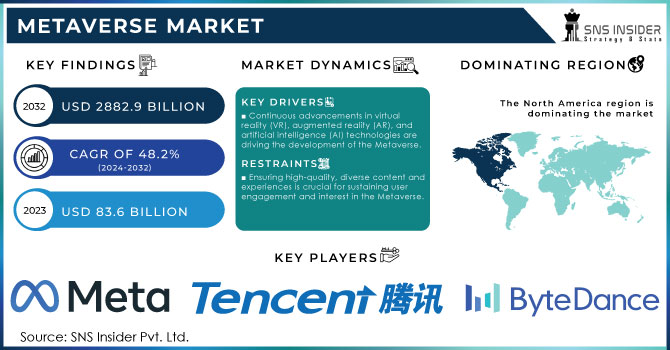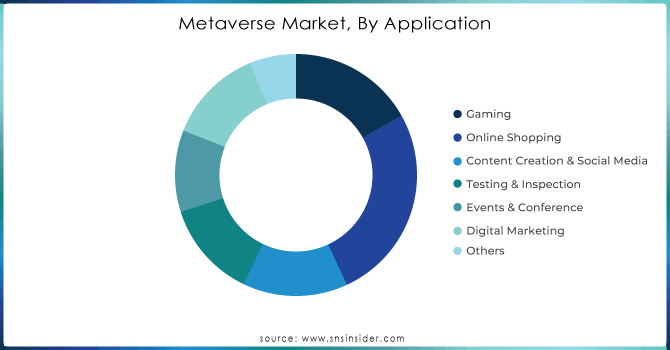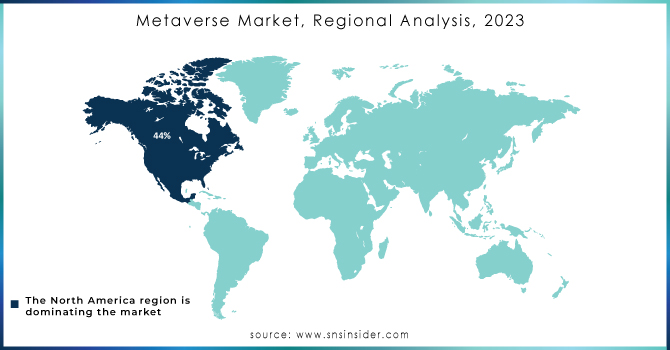Metaverse Market Report Scope & Overview:
The Metaverse Market size was USD 52.96 Billion in 2023 and is expected to reach USD 1599.72 Billion by 2032, growing at a CAGR of 46.0% over the forecast period of 2024-2032. Spatial technologies are innovative as they integrate human interaction with digital objects that are parts of the real world. Companies are increasingly adopting the technology to create immersive products and services for users, promoting innovation for the customers.

Get More Information on Metaverse Market - Request Sample Report
For instance, in January 2024, Unity Technologies unveiled spatial collaboration with Apple Inc. aimed at advancing spatial experiences, particularly in augmented reality and spatial computing. However, the company seeks to take the application of spatial technology a notch higher by devising services that can allow developers to offer immersive experiences across the applications with digital content that seamlessly matches the physical landscape.
In 2023, global investments in metaverse-related projects, including VR/AR and blockchain technologies, exceeded $120 billion. As part of that, investment into metaverse-focused platforms and applications was significant, in some cases exceeding $ 1 billion. As such, by the end of 2023, the total number of patents relating to the metaverse technology reportedly amounted to more than 5,000. As a result, the technologies AR, VR, MR and 3D visualization tools are pushing the market growth higher and further, offering new opportunities for more immersive experience to the users.
The industries are increasingly including AR, VR, MR, and 3D visualization applications for improved visualization, simulation, and prototyping. Growing investments and partnerships across the industries as well as customer needs shaping the demand are increasingly stimulating the market expansion. Entertainment, gaming, and education are further spearheading the demand for more immersive experiences, encouraging firms to invest in the technologies via the new application development. Cryptocurrencies are shaping the transactions, becoming the base of digital world economy by decentralizing the digital economy that facilitates efficient transactions across the metaverse. NFTs are revolutionizing ownership by certifying the uniqueness of digital assets, adding new value dimensions and driving the creation of diverse digital collectibles.
Market dynamics
Drivers
- Continuous advancements in virtual reality (VR), augmented reality (AR), and artificial intelligence (AI) technologies are driving the development of the Metaverse.
- Growing use of Metaverse in Healthcare industry drives the market.
- Consumers are increasingly seeking immersive digital experiences, driving demand for Metaverse platforms and content.
- The rise of digital economies and online marketplaces presents opportunities for commerce and social interaction within the Metaverse.
Various technological developments, specifically those in virtual reality and artificial intelligence, play a crucial role in shaping the Metaverse’s development. In the year 2023, global shipments, sales, and distribution of VR and AR gadgets were more than 12 million units, indicating the need and use for standard hardware that supports Metaverse. In addition, several other agencies and governments are taking the steps of sponsoring, making these more and more vital. In South Korea spent more than $186 to ensure that the national metaverse technology succeeds as well as establish itself as the metaverse hub globally by 2023. AI is centered in the Metaverse, and AI mainly deals with changing the interaction between humans and their digital lives by providing more realistic and responsive virtual environments.
For instance, AI-driven avatars and virtual assistants are becoming more prevalent, offering personalized experiences that adapt to individual user preferences. These technological advancements are not only enhancing user experiences but are also driving the evolution of the Metaverse as a dynamic, interconnected digital space where people can work, play, and socialize in ways previously unimaginable.
The increasing use of metaverse in healthcare drives the market. Doctors can now virtually connect with patients anywhere, driving virtual wellness and consultations. Technologies such as AR, VR, and AI will transform medicine. Imagine doctors practicing surgery on digital twin dummies, or patients receiving personalized therapy in virtual environments. This technology, combined with secure data storage via blockchain, holds immense potential for improved engagement, education, and overall healthcare.
Restraints
- Overcoming technical hurdles such as latency, bandwidth limitations, and device compatibility remains a significant barrier to widespread adoption.
- Ensuring high-quality, diverse content and experiences is crucial for sustaining user engagement and interest in the Metaverse.
- Evolving regulatory frameworks and legal considerations regarding virtual property rights, taxation, and governance pose challenges to Metaverse development and operation.
Opportunities
- Metaverse presents vast opportunities for content creators, developers, and businesses to monetize digital assets, services, and experiences.
- Platforms within the Metaverse offer opportunities for social interaction, community building, and new forms of entertainment and communication.
- E-commerce and digital transactions within the Metaverse enable new revenue streams for businesses and enhance the overall shopping experience.
Segment analysis
By Product
The hardware segment dominated the market due to firms focusing on improving user experiences and immersion and is expected to maintain the largest revenue share. Companies are innovating with advanced hardware such as VR/AR headsets and haptic devices to enhance virtual realism. Developing interfaces for accessing 3D content across various devices, including next-gen TVs and smart glasses such as HoloLens, will drive revenue growth. For example, Facebook Reality Labs plans to invest over USD 10.02 billion in AR and VR hardware development.
The software segment, witnessing significant growth, involves creating integrated virtual simulations for diverse activities and businesses, with popular platforms such as Minecraft and Roblox driving revenue growth alongside increasing smartphone penetration and app developer rates.
By Application
In 2023, the Gaming segment dominated the Metaverse Market held a revenue share of more than 26%, driven by ongoing innovations and efforts to enhance immersion and realism in games. Businesses increasingly leverage gaming to bolster their corporate image, further driving the revenue growth. Market applications include gaming, online shopping, content creation & social media, events & conferences, digital marketing, testing, and others.
The content creation & social media segment is projected to grow notably, fueled by the reliance on internet and social platforms, spawning an increase in content creators. Virtual reality training, particularly for aircraft inspection and cabin crew training, provides immersive, safe learning environments, enhancing skills without physical presence.

Need any customization research on Metaverse Market - Enquiry Now
By technology
The virtual reality and augmented reality segment dominated the market with held more than 35% revenue in 2023 driven by their ability to create experience interaction with virtual environments like never before. Specifically, VR and AR provide users with immersive experiences, which capture many senses and are oriented toward engagement. These solutions are relevant for a wide range of industries, including gaming, entertainment, education, and healthcare as a consequence, the demand for VR and AR has been on the rise. The growing interest in VR and ARs from virtual meetings and training simulations to product visualization, cater to diverse needs, further boosting their popularity.
MR is expected to experience the highest CAGR from 2024 to 2032. MR uniquely combines aspects of both VR and AR, creating a seamless blend of virtual and real-world environments. MR solutions are immersive and interactive, which makes the users of these technologies feel like they are present in the experience. At the same time, they make it possible to interact with virtual objects in the physical world, which creates versatile affordances across industries. Specifically, MRs can be used for gaming, learning, business organization, and healthcare. The category is practiced on headsets and glasses, the use of which is expected to increase with the continued development of software.
Regional analysis
The North America region dominated the market in 2023, and accounted for more than 44% of the share. This fact could be attributed to the characteristics of the region’s population as a result of their being the early adopters of the latest technological advancements. One of the trends is the investment in VR headsets, gaming consoles with metaverse concepts, and high-speed internet access to enable more pleasant VR experiences. These factors create a strong market foundation for metaverse products and services. Additionally, the existing broad gaming culture in the region contributes substantially to Roblox Corporation’s and Epic Games’ development of Roblox and Fortnite, the platforms that incorporate key metaverse elements.
The metaverse market in the U.S. is set to grow between 2024 and 2032 in a relatively significant growth rate. This fact would happen as a result of the prices of VR and AR technologies becoming more affordable and the growing consumers’ and businesses’ interests in the digitalized experiences. The CAGR of Asia Pacific is expected to be the highest between 2024 and 2032. This fact is determined by invested in smart cities, digital economy, and 5G technology in the region in such countries as Japan, South Korea, and China playing a key role.

Key Players
The key market players include Meta Platforms, Inc., Tencent Holdings Ltd,.ByteDance Ltd., NetEase, Inc., Nvidia Corporation, Epic Games, Inc., Roblox Corporation, Unity Technologies, Inc., Lilith Games Nextech AR Solutions Corp , The Sandbox Active Theory, Decentraland , Microsoft Corporation & Other Players.
| Report Attributes | Details |
| Market Size in 2023 | USD 83.6 Bn |
| Market Size by 2032 | USD 2882.9 Bn |
| CAGR | CAGR of 48.2% From 2024 to 2032 |
| Base Year | 2023 |
| Forecast Period | 2024-2032 |
| Historical Data | 2020-2022 |
| Report Scope & Coverage | Market Size, Segments Analysis, Competitive Landscape, Regional Analysis, DROC & SWOT Analysis, Forecast Outlook |
| Key Segments | • By Product (Infrastructure, Hardware, Software, Services) • By Technology (Blockchain, Virtual Reality (VR) & Augmented Reality (AR), Mixed Reality (MR), Others) • By Platform (Desktop, Mobile, Headsets) • By Application (Gaming, Online Shopping, Content Creation & social media, Events & Conference, Digital Marketing (Advertising), Testing and Inspection, Others) • By End-use (BFSI, Retail, Media & Entertainment, Education, Aerospace and Defense, Automotive, Others) |
| Regional Analysis/Coverage | North America (US, Canada, Mexico), Europe (Eastern Europe [Poland, Romania, Hungary, Turkey, Rest of Eastern Europe] Western Europe] Germany, France, UK, Italy, Spain, Netherlands, Switzerland, Austria, Rest of Western Europe]), Asia Pacific (China, India, Japan, South Korea, Vietnam, Singapore, Australia, Rest of Asia Pacific), Middle East & Africa (Middle East [UAE, Egypt, Saudi Arabia, Qatar, Rest of Middle East], Africa [Nigeria, South Africa, Rest of Africa], Latin America (Brazil, Argentina, Colombia, Rest of Latin America) |
| Company Profiles | Meta Platforms, Inc., Tencent Holdings Ltd, ByteDance Ltd., NetEase, Inc., Nvidia Corporation, Epic Games, Inc., Roblox Corporation, Unity Technologies, Inc., Lilith Games Nextech AR Solutions Corp, The Sandbox Active Theory, Decentraland, Microsoft Corporation |
| Key Drivers | • People use websites, chat applications, and social networking platforms like Facebook to connect with one another online. • Investors may benefit by selling crypto because it is available on exchanges all around the world |
| Restraints | • A rise in cyber-attacks and a high-risk environment might stymie industry expansion. |

